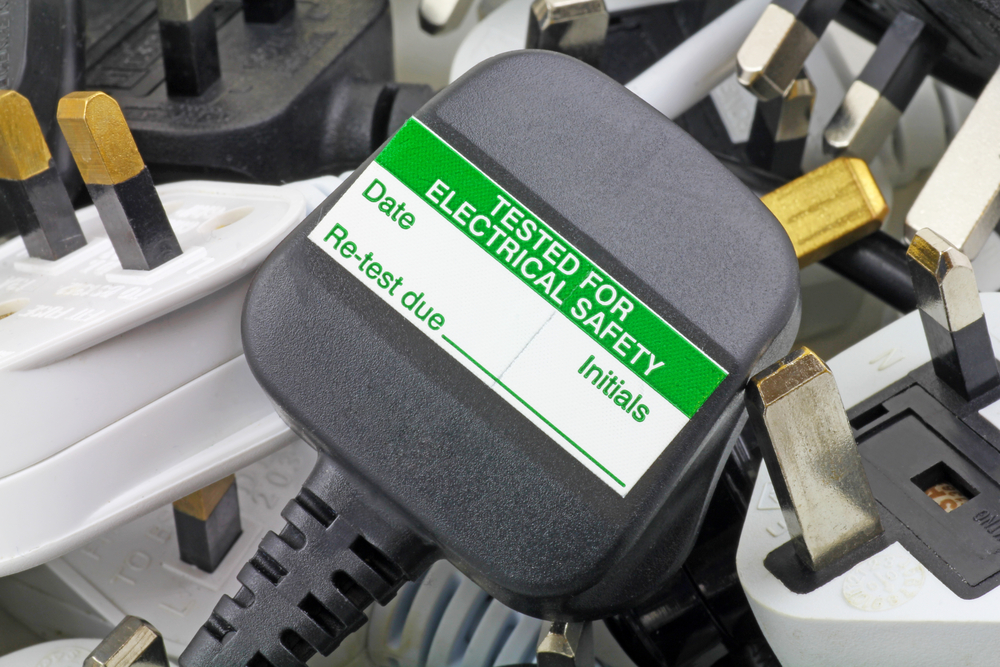Electrical safety in rental properties is one of the most important responsibilities a landlord holds. Among the terms often mentioned in this context is Portable Appliance Testing (PAT). But what exactly does it mean, and is it legally required for landlords?
If you’re renting out a property in the UK, it’s crucial to understand your duties when it comes to electrical safety and PAT testing.
This guide explains the legal landscape in simple terms and helps you determine what action, if any, you need to take to stay compliant and protect your tenants.
Table of Contents
What Is PAT Testing and Why Do Landlords Need It?
PAT testing, or Portable Appliance Testing, is a process used to check the safety of electrical appliances. Its primary aim is to ensure that appliances provided in a property are in good working order and pose no risk to users.
The process typically begins with a thorough visual inspection. This includes examining the appliance itself, as well as its plug and power cable, for any visible signs of damage such as fraying, burns, or loose connections.
Following the visual check, electronic testing is carried out using a specialized PAT device. This equipment measures various aspects of the appliance’s electrical safety, including insulation resistance, earth continuity, and, in some cases, functionality. These tests help identify hidden faults that may not be apparent from a visual inspection alone, providing a more complete picture of the appliance’s safety.
For landlords, PAT testing can be an essential part of maintaining a furnished or partly furnished rental property. Ensuring that all electrical items supplied to tenants are safe is not just good practice—it also plays a critical role in preventing electrical accidents and avoiding potential legal complications. By proactively testing appliances, landlords demonstrate a commitment to tenant safety while protecting themselves from liability in the event of an incident.
Is PAT Testing a Legal Requirement for Landlords?
Contrary to popular belief, PAT testing is not a specific legal requirement for landlords under current UK law. However, landlords are legally required to ensure electrical equipment is safe at the start of the tenancy and remains so throughout.
This general duty falls under:
- The Electrical Equipment (Safety) Regulations 1994
- The Housing Act 2004 and the Housing Health and Safety Rating System (HHSRS)
- The Landlord and Tenant Act 1985, requiring landlords to maintain properties in a safe condition
PAT testing is therefore not mandatory, but it is considered best practice and may be used to prove that the landlord has taken reasonable steps to ensure safety.
Landlord PAT Testing – Key Facts and Criteria
Here are the essential points landlords should keep in mind:
- Applies to portable electrical appliances: anything with a plug that can be moved (e.g. kettles, toasters, lamps, microwaves)
- Furnished or part-furnished properties are most affected
- Visual checks should be done regularly, even if full PAT testing is not required
- PAT testing is recommended at each change of tenancy or annually for higher-risk appliances
- Appliances should carry a pass/fail sticker with the date of the last test, if tested
While not a legal obligation, many landlords opt for PAT testing to stay on the safe side.
Who Is Responsible for PAT Testing in a Rental Property?
The landlord is responsible for ensuring that any electrical appliance provided as part of the rental agreement is safe to use. This includes:
- Appliances in furnished properties
- Communal appliances in HMOs (Houses in Multiple Occupation)
- Electrical items supplied with short-term or holiday lets
If tenants bring their own appliances, the landlord is not responsible for testing those.
Letting agents managing properties on behalf of landlords may assist in arranging PAT testing but the legal duty ultimately remains with the landlord.
What Are Landlord PAT Testing Legal Requirements in England?
In England, there is currently no specific statute that explicitly requires landlords to carry out Portable Appliance Testing (PAT). However, landlords still have a legal obligation to ensure the electrical safety of the properties and items they provide to tenants. This responsibility is outlined in several key regulations.
One of the primary legal requirements is the Electrical Safety Standards in the Private Rented Sector (England) Regulations 2020. Under this legislation, landlords must have the electrical installations within their rental properties—such as wiring, sockets, and fuse boxes—inspected and tested by a qualified electrician at least once every five years. It is important to note that this regulation applies to fixed electrical installations, not to portable appliances.
In addition to this, landlords are also bound by general product safety laws. These laws require that all items supplied with a rental property, including electrical appliances, be safe for use. Even if PAT testing is not mandated by law, landlords must still be able to demonstrate that all appliances they provide are safe and fit for purpose.
Although PAT testing is not a legal requirement, it is widely regarded as the most straightforward and credible method for proving the safety of electrical appliances. By having appliances tested and labelled accordingly, landlords can demonstrate due diligence in fulfilling their safety obligations and protecting their tenants.
PAT Testing for Rental Properties
Landlords of rental properties should take several important considerations into account when it comes to electrical safety and appliance testing. One of the first questions to ask is whether you provide electrical appliances as part of the tenancy. If so, it is strongly recommended that you carry out Portable Appliance Testing (PAT). While not legally required in all cases, PAT testing is a reliable way to demonstrate that the appliances you supply are safe for tenant use.
PAT Testing For Houses in Multiple Occupation
If your property is a house in multiple occupation (HMO) and requires a licence, additional requirements may apply. Many local authorities include PAT testing as part of their licensing conditions. Therefore, it is essential to check the specific requirements set out by your local council, as failure to comply could result in penalties or issues with your licence renewal.
For landlords managing multiple properties, keeping organised records of appliance inspections and PAT test results can be particularly beneficial. A consistent approach to documenting these checks not only helps maintain compliance but also ensures that safety procedures are applied uniformly across all properties.
In general, most landlords find that conducting PAT tests on an annual basis offers significant peace of mind. Regular testing can make the process much simpler if an inspection takes place or if there is an incident involving electrical equipment. It shows a proactive approach to tenant safety and can help protect both the landlord’s legal position and the wellbeing of those living in the property.
Concerned About Your Property's Compliance?
PAT Testing for Holiday Rentals
Holiday lets, serviced accommodation, and Airbnb properties present a unique set of risks compared to standard rental properties. One of the main factors contributing to this difference is the frequent turnover of guests. With more people coming and going, electrical appliances are subject to increased use, which leads to greater wear and tear. This higher usage can accelerate the deterioration of equipment and raise the likelihood of faults developing.
Another challenge is that guests in short-term accommodation are less likely to report faulty or malfunctioning equipment. Unlike long-term tenants, they may not feel responsible for notifying the landlord or managing agent about potential safety issues. As a result, faults can go unnoticed and unaddressed for longer periods. Additionally, many landlords of holiday lets or serviced properties do not visit their properties regularly, which further limits opportunities to spot issues with electrical appliances.
Given these factors, regular Portable Appliance Testing (PAT) is strongly recommended for short-term rental properties. While PAT testing is not legally required in most cases, it is often expected by insurance providers and may be a condition of coverage. Moreover, some local councils include PAT testing as part of their licensing requirements for holiday lets. Failing to comply could affect your ability to operate legally or obtain the necessary permissions.
What Happens If a Landlord Does Not Obtain or Pass a PAT Test?
Since Portable Appliance Testing (PAT) is not a legal requirement for landlords in most cases, there are no direct penalties for choosing not to carry out the tests. However, the absence of a legal obligation does not mean there are no serious consequences for neglecting appliance safety. Landlords still have a duty of care to ensure that all electrical items provided in a rental property are safe to use.
If a tenant or guest is injured as a result of a faulty appliance, the landlord could be held liable for damages. In such cases, the ability to demonstrate that reasonable safety checks were conducted—including PAT testing—can be a critical factor in determining liability. Without documented proof of safety measures, landlords may also be exposed to enforcement action under the Housing Health and Safety Rating System (HHSRS), which local authorities use to assess potential hazards in rental homes.
Additionally, failure to carry out PAT testing may complicate matters with insurance providers. If an electrical incident leads to a claim, insurers may require evidence that reasonable steps were taken to ensure the appliance involved was safe. If you are unable to provide this evidence, your claim may be reduced or denied altogether.
For all these reasons, PAT testing should be seen as a practical risk management strategy rather than merely a compliance formality. It helps protect tenants, supports your legal and insurance position, and demonstrates a responsible approach to property management.
PAT Testing For Landlord: Summary & Takeaways
While not legally required, PAT testing is a widely recommended best practice for landlords, particularly in furnished or holiday rental properties. It supports your legal duty to supply safe appliances and provides evidence if things go wrong.
Key points to remember:
- PAT testing isn’t required by law, but electrical safety is
- It helps protect tenants, landlords, and property managers
- Simple visual checks are often enough, but professional PAT testing adds credibility
- Keeping records helps demonstrate due diligence
If you’re unsure whether your property needs PAT testing, speak to your letting agent or property management company. Prime Residential can help assess your property needs and coordinate electrical safety checks as part of a fully compliant management package.
- PAT testing isn’t required by law, but electrical safety is
- It helps protect tenants, landlords, and property managers
- Simple visual checks are often enough, but professional PAT testing adds credibility
- Keeping records helps demonstrate due diligence










